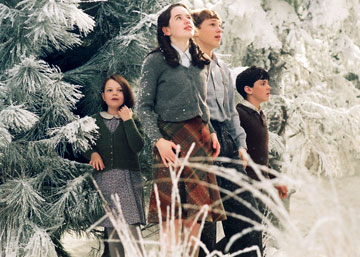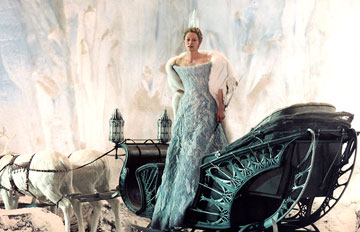Rating
-

Cast & Crew
info:
Children’s/Fantasy (US); 2005; Rated PG
for battle sequences and frightening moments; Running
Time: 140 Minutes
Cast
Georgie Henley
Lucy Pevensie
Skandar Keynes
Edmund Pevensie
William Moseley
Peter Pevensie
Anna Popplewell
Susan Pevensie
Tilda Swinton
White Witch
James McAvoy
Mr. Tumnus
Jim Broadbent
Professor Kirke
Liam Neeson
Aslan
Produced by
Andrew Adamson, Douglas Gresham, Mark Johnson, Perry Moore,
Philip Steuer; Directed by Andrew Adamson;
Written by Ann Peacock, Andrew Adamson,
Christopher Markus and Stephen McFeely; based on
the novel by C.S. Lewis
Official
Site
Domestic Release Date:
December 9, 2005
Review Date
02/10/06 |
 Written
by DAVID KEYES Written
by DAVID KEYES
Stories
about kids have been known to get away with just about anything,
perhaps because, unlike real life, literature isn’t
bogged down by grave world events like child kidnappings
or mysterious disappearances. On the printed page, their
lived unfold as well as they deserve, without unnecessary
tragedy but full of the kind of curiosity that gives their
adventures the suggestion of fearsome danger. Admittedly,
some of us who go into stories like these with preconceived
perceptions of the harshness of reality might find some
things a bit too hard to swallow. The kids in the Narnia
chronicles are a particularly worrisome bunch, not so much
for their own naïve inquisitiveness but for their basic
nature to jump the gun and trust things that for any normal
kid would seem a little too colorful and unreal to believe
in. Of course, all of this is never much of a forethought
when we are kids ourselves, but as adults it would be foolish
to deny that our eyebrows do not raise a little at the mere
notion of something like a little girl being eager to go
home “for tea” with a half-human stranger she
meets by a lamppost.
The elusive charm of C.S. Lewis’ Narnia is that it
represents a time and space when realism is just a formality;
its rich and vivacious narrative canvas simplifies life
into very basic fundamentals, and creates a journey that
will whisk four ordinary children into quests galore that
require little more than basic survival instinct. Who cares
if one of them is too inexperienced to know when an evil
white witch is manipulating him? Who cares if none of them
know how to respond when meeting a couple of talking beavers?
And who cares if their limited exposure to life makes it
impossible for them to see just how important their future
tasks will be? Curiosity may lead to trouble, but in fantasy
literature it is also the spring board for the most spirited
of quests.
A lot of these notions occupy a good chunk of the fabric
that makes up Andrew Adamson’s “The Chronicles
of Narnia: The Lion, the Witch and the Wardrobe,”
an engaging and visually-stimulating adaptation of the first
book of Lewis’ immortal seven-part Narnia series.
In it, four young members of the Pevensie family are sent
away from war-torn Britain to reside in the peaceful countryside,
where they will share quarters with a mysterious old professor
in a rickety old mansion decorated with historical artifacts.
Here, behind the mysteriously large doors of an old wardrobe
in the corner of an empty upstairs bedroom, is the gateway
to a realm very unlike that of our own: a place where mystical
creatures roam, ordinary animals talk, and magic seems to
spring from the soil as easily as trees. That a most curious
girl named Lucy is the first to encounter this place makes
the discovery all the more significant. Ordinary people
would bog down their astonishment with caution and uncertainty;
here is a girl who sees so much beauty surrounding her that
she doesn’t consciously think about the dangers lurking
behind the corners. At times she looks at the world with
such vivacious enthusiasm that we feel like we can explore
it right along with her, caught up so much in its freshness
and purity that the hidden menaces would seem irrelevant,
almost nonexistent.
Lucy’s return to her world, alas, does not yield the
results she hopes. Her siblings dismiss the findings as
little more than childhood daydreaming. Then her antagonistic
brother Edmund, a cynic at heart, follows her into the wardrobe
and arrives at the same destination. When he does, he crosses
the path of the self-proclaimed “Queen of Narnia,”
a persuasive and calculating manipulator who preys on his
inability to sniff out hidden agendas. Hers is that her
throne is threatened by the arrival of girls and boys from
the human world, who, as legend has it, would bring an end
to her firm grasp on the land and return power to the common
beings that inhabit them. When you’re actually an
evil witch whose primary motivation is all about power,
though, it is natural that you would feel so threatened.
 The
White Witch is an awkward but brilliantly eccentric character
that demands restrained emotion and solid physical presence.
She entices Edmund with such a cunning delivery of promises
of glory and grandeur that he is sold almost immediately,
never once questioning the possibility that the first being
he meets on the other side of the wardrobe doors could be
capable of so much harm. The fact that his own siblings
perceive him and his abrasive actions so negatively only
fuel that fire; he occupies the narrative with a major chip
on his shoulder, as if he has to prove something to all
three of his relatives, and when the Witch tells him that
he could be king of Narnia if he brings the three others
to her custody, he sees it as the perfect opportunity to
upstage and overpower those who doubt him. It never crosses
his mind that he might be making the ultimate betrayal. The
White Witch is an awkward but brilliantly eccentric character
that demands restrained emotion and solid physical presence.
She entices Edmund with such a cunning delivery of promises
of glory and grandeur that he is sold almost immediately,
never once questioning the possibility that the first being
he meets on the other side of the wardrobe doors could be
capable of so much harm. The fact that his own siblings
perceive him and his abrasive actions so negatively only
fuel that fire; he occupies the narrative with a major chip
on his shoulder, as if he has to prove something to all
three of his relatives, and when the Witch tells him that
he could be king of Narnia if he brings the three others
to her custody, he sees it as the perfect opportunity to
upstage and overpower those who doubt him. It never crosses
his mind that he might be making the ultimate betrayal.
Be it through eyes of optimism or pessimism, the movie knows
exactly what it is like to be a child. Young imaginations
love the idea of being caught up in a rip-roaring adventure,
ignoring the potential consequences of such tasks because
they see glory, seldom sacrifice. Lewis’ narrative,
too, does a great job of emphasizing those points through
the eyes of its young heroes. Consider, for instance, a
scene in the film in which the Pevensie children are confronted
by the White Witch’s band of hunting wolves near an
icy waterfall, or when they enter a battlefield commanded
by a talking lion named Aslan. The realizations are just
as powerful for them as they are for the youngsters who
are consuming the story. They sympathize with the four kids,
laugh and cry right along with them during all of their
adventures, and by the end they feel like they have grown
to understand more of the world right along with the ones
that have been subject to all the action.
I would be lying, of course, if I didn’t admit to
being very caught up in this saga. Lewis’ books were
a personal detour on several occasions over the years, and
each time I read them I was caught up so passionately in
the tales that I felt more like a participator rather than
just an outside viewer. It takes more than just an understanding
of kids, furthermore, to make such a successful transition
from the books to the screen. Several fail, alas; just ask
the early directors of the “Harry Potter” films,
who upstaged the childhood sensibility of the story’s
main characters in favor of incessant visual effects. Here,
Adamson has touched on the center point of his subject matter
so well that the transition is fluid. Aside from being consciously
aware of the mentality of his four main personas, he knows
how to handle images without having them totally overwhelm
the whole foreground. Some of the effects are almost completely
unrecognizable, even; centaurs, griffins and polar bears
rush off the screen not like stylized cartoon dramatizations,
but rather like authentic, living and breathing beasts.
WETA Digital, the brains behind the digital masterpiece
that is Andy Serkis’ Gollum, continues to thrive on
their ability to pass of illusion as the real thing.
Perhaps most pleasing is the fact that the picture also
does not directly make the narrative connection to Christian
allegory that so many might have assumed. Sure, imagery
references are heavy on the themes on some occasions, particularly
during battle – a fellow critic was quick to note
that all of the animals used on the side of the White Witch
were known symbols of pagan study – but unless one
consciously looks for it, the entire sentiment almost goes
unnoticed. And that’s a surprise, especially considering
the fact that Walden Media’s primary promotional blitz
was backed by the same religious-driven people who got out
the good word for Mel Gibson’s “The Passion
of the Christ.” Could it be that those behind the
camera went this route because they desired a more universal
appeal? Or were they just not intent to touch that subject
period? Either way, their decision to dust away the footnotes
of this story is wise; the characters and their plot lines
place far more emphasis on the fantasy element rather than
the religious one, and in the process we don’t feel
like we’re sitting in Church on Sunday listening to
the preacher’s latest sermon.
In terms of sheer oomph and exercise, “The Chronicles
of Narnia: The Lion the Witch and the Wardrobe” is
hardly going to set the world on fire in, say, the same
manner that the “Lord of the Rings” trilogy
did, but what it does do is bring that scope of imagination
down to a more accessible level for the kids. The movie
is beautiful to look at, fun to observe, and at some intervals
nostalgic for those who grew up with the stories. The benchmark
for a new movie series has been set, and now it remains
to be seen whether Aslan the Lion’s roar can be just
as loud the second or third time around as it was on the
first occurrence.
© 2005, David Keyes, Cinemaphile.org.
Please e-mail the author here
if the above review contains any spelling or grammar mistakes. |





